Key takeaways:
- Typography is crucial in design and branding, as it reflects brand identity and evokes emotions in the audience.
- Current trends emphasize minimalism, variable fonts, and custom typography to enhance usability and brand authenticity.
- Legibility and the suitability of typography choices significantly impact user experience and perceptions of brand credibility.
- Experimentation and audience understanding are key when selecting typography to ensure resonance and connection.
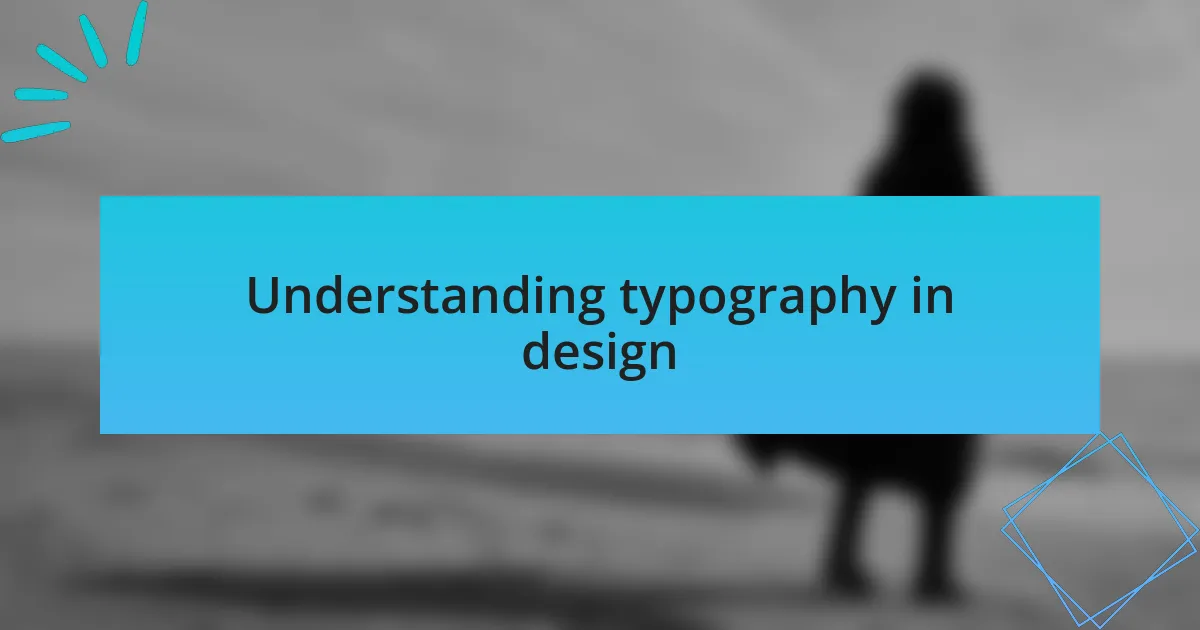
Understanding typography in design
Typography plays a pivotal role in design, serving as the visual voice of a brand. I often find myself drawn to how different typefaces can evoke distinct emotions—consider how a bold serif might impart a sense of reliability, while a sleek sans-serif feels modern and approachable. Have you ever noticed how the right font can make a piece of writing resonate deeper?
When I first began designing, I underestimated the importance of line spacing and letter spacing. It was eye-opening to realize that even small adjustments could dramatically enhance readability and overall aesthetic. I remember launching a project only to see feedback asking for tweaks in spacing, and it turned out to be a game-changer for the design’s impact.
There’s something undeniably personal about choosing fonts; each decision reflects a part of the story I want to tell. I often ask myself, “What feelings do I want my audience to experience?” This thought guides my typography choices and shapes how viewers connect with the design. Typography is not just about letters; it’s about the emotions they communicate.

Importance of typography in branding
When it comes to branding, typography isn’t just an afterthought—it’s foundational. I remember working on a project for a startup that opted for a quirky, playful font. It initially seemed like a fun choice, but as I observed their customer’s reactions, it became clear that the typography clashed with the brand’s message of professionalism. This experience reinforced my belief that typography needs to align perfectly with brand values to foster the right associations.
Choosing the right typeface can speak volumes about a brand’s identity. I’ve seen how a clean, elegant font can enhance luxury perception, while a bold, chunky type can convey strength and stability. I’ve experimented with various styles, and I often ask myself how these choices might influence a consumer’s perception. Does the font say “trustworthy” or “experimental”? The answers often guide my design decisions.
The consistency of typography across platforms is crucial in creating a cohesive brand experience. I’ve had clients who maintained distinct styles on their websites and social media, leading to a disjointed presence. By standardizing their typographic choices, we enhanced their identity, allowing their audience to recognize their brand instantly, regardless of the medium. It’s fascinating how a consistent visual tone can solidify a brand in the minds of consumers.
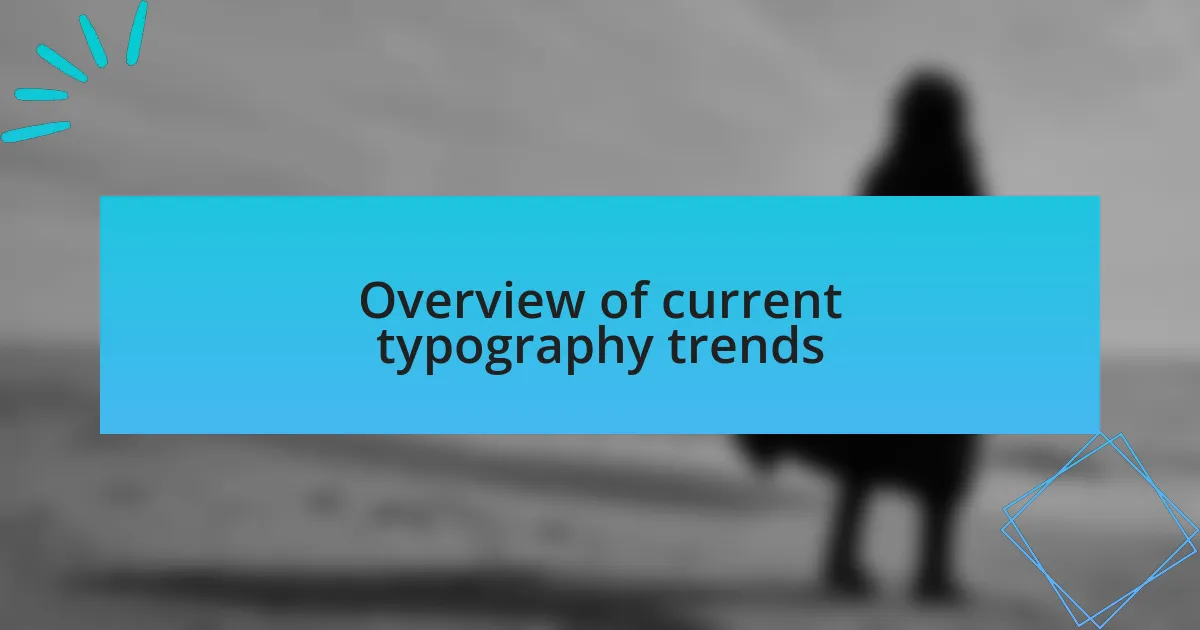
Overview of current typography trends
Current typography trends reflect a shift towards minimalism and simplicity, embracing clean lines and sans-serif fonts. I recently worked with a nonprofit that wanted to enhance readability in their educational materials. We chose a straightforward typeface that not only improved clarity but also resonated with their mission of accessibility. Isn’t it fascinating how a simple font can make complex information more digestible?
Another trend that I find particularly compelling is the rise of variable fonts. They allow for greater flexibility without overwhelming designers with multiple typefaces. In a recent branding project, we experimented with a variable font that adapted to different screen sizes, creating a user-friendly experience. How often do we consider how typography affects usability? I believe this trend makes a strong case for prioritizing functionality alongside aesthetics.
Finally, I’ve noticed a resurgence of custom typography, where brands create unique typefaces that truly reflect their identity. While working on a tech startup’s visual identity, we developed a bespoke font that embodied their innovative spirit. It was thrilling to see how that personal touch conveyed authenticity and fostered emotional connections with their users. Isn’t it amazing how the right typeface can encapsulate a brand’s essence in such a visual and impactful manner?
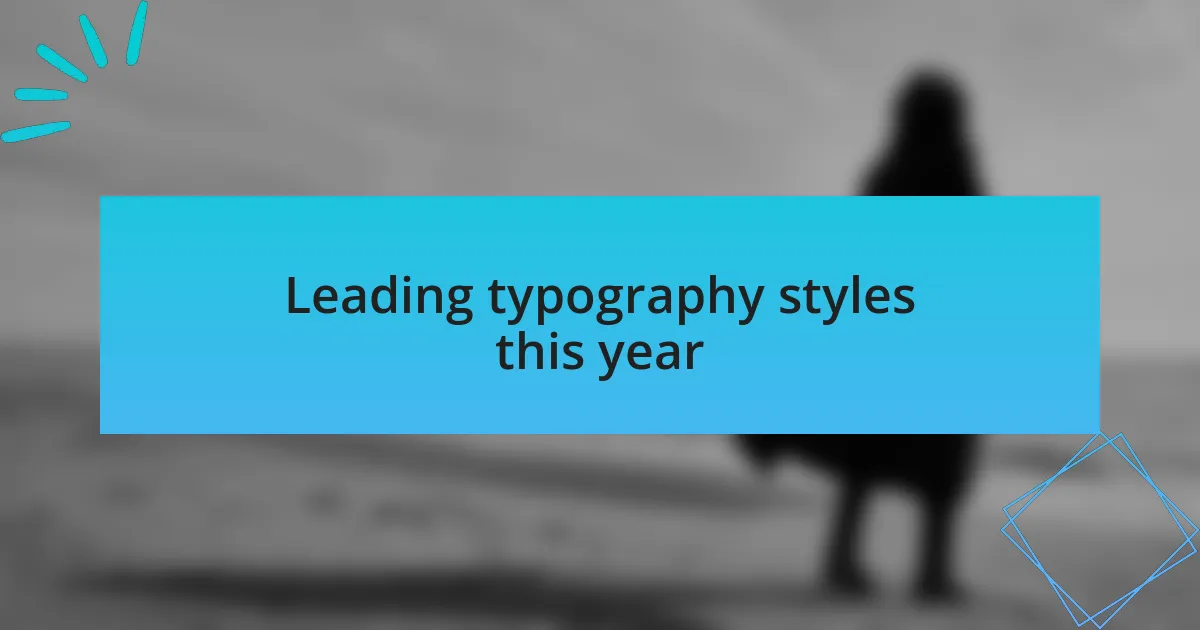
Leading typography styles this year
This year, one leading typography style is bold, oversized type. I recently came across a campaign where the brand used gigantic headlines that practically jumped off the page. It instantly captured my attention and drew me into the message. Doesn’t it grab your attention when a typeface practically shouts at you? Bold typography can convey excitement and urgency, making it perfect for sales or important announcements.
Another exciting trend I’ve observed is the incorporation of organic, hand-drawn typography. While collaborating with a local café on their branding, we opted for a custom hand-lettered look that evoked warmth and a personal touch. It was incredible to see how that choice transformed the design and made the space feel more inviting. Don’t you think that a handwritten font can create a connection that digital type sometimes lacks?
Lastly, I can’t help but notice the trend towards mismatched typefaces. By pairing a clean sans-serif with a more decorative serif font, I’ve seen projects come alive with personality. In a recent website redesign for an artisanal craft store, this contrast not only made the text more engaging but also reflected the eclectic nature of their products. Isn’t it interesting how a little contrast can add depth and character to a design?
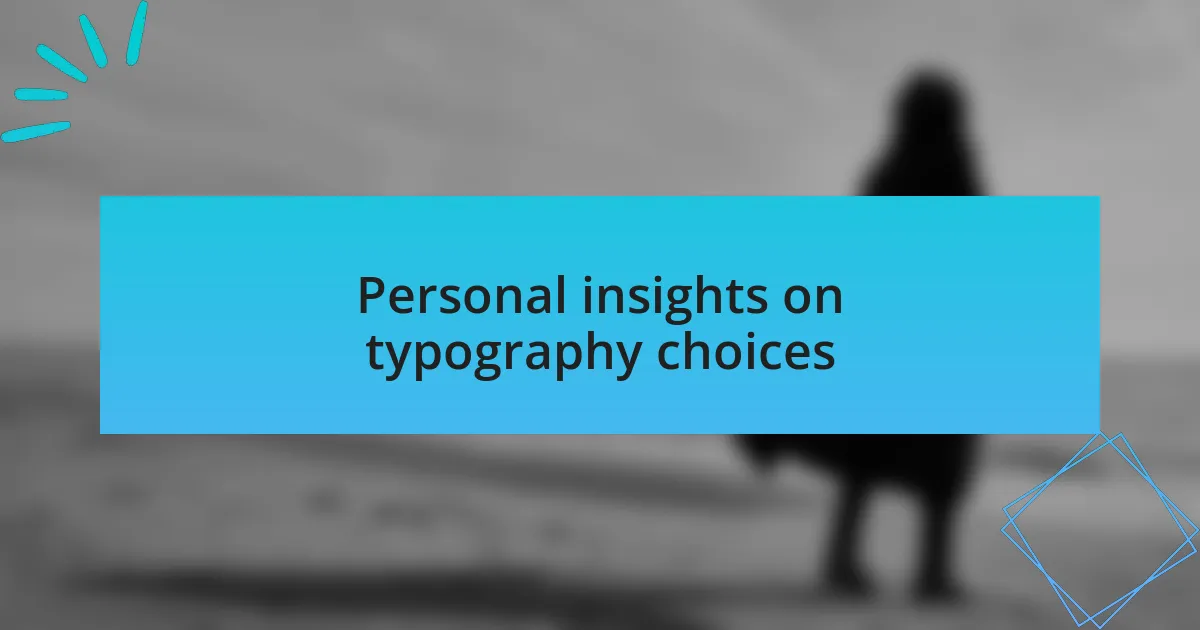
Personal insights on typography choices
When I choose typography for a project, I often reflect on how it will resonate emotionally with the audience. For instance, during a recent design for a children’s book, I opted for a playful, bubbly font that instantly felt cheerful and accessible. That feeling of delight when seeing a child engage with the story was incredibly rewarding for me; it reinforced my belief that type can genuinely enhance emotional connection. Does it make you smile to think how something as simple as a font can evoke joy?
I’ve also been experimenting with variable fonts more this year. In one of my latest branding projects, I used a variable font that could morph in weight and style depending on the context. This adaptability not only allowed us to stay flexible with our design choices but also added an exciting layer to the user experience. How cool is it that the same typeface can shift to reflect different moods without losing its identity?
Lately, I’ve been drawn to minimalist typography that leans heavily on white space. While designing a sleek website for a tech startup, I learned that reducing clutter can significantly amplify clarity. The straightforwardness allowed the message to shine through, preventing distractions. Don’t you find that sometimes less truly is more, especially in a world filled with visual noise?
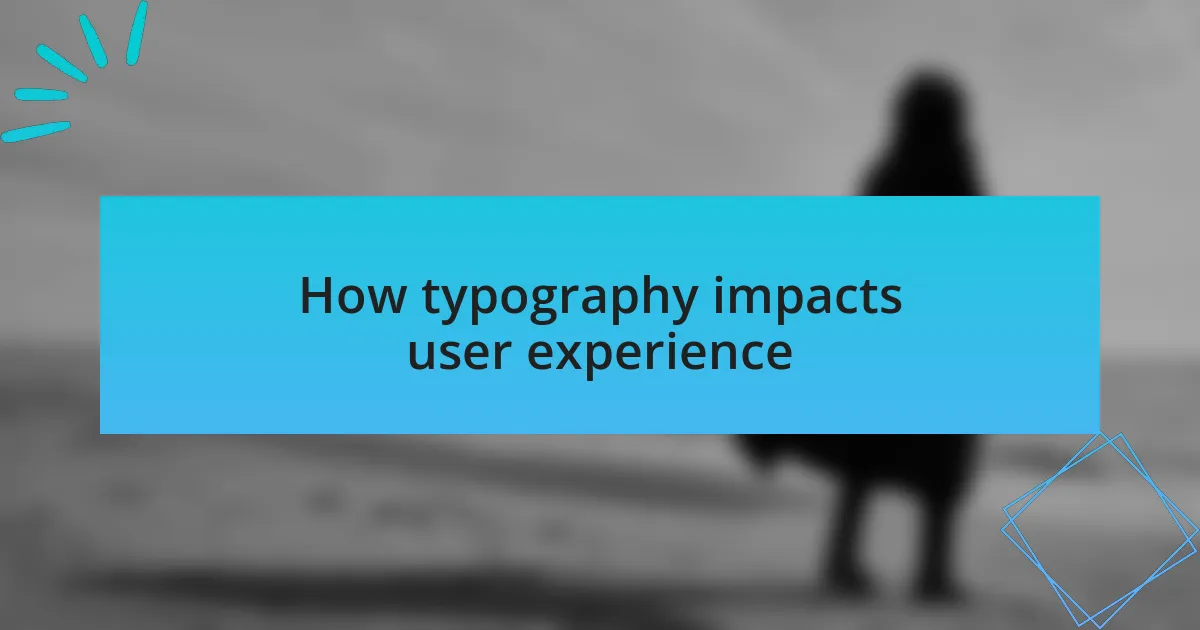
How typography impacts user experience
When I think about typography’s impact on user experience, one memory stands out. While working on a travel website, I chose a dynamic, modern typeface that breathed life into the content. The feedback was astounding—users felt a sense of adventure just from reading the headlines. Isn’t it fascinating how the right font can set the tone before users even dive into the text?
Moreover, I’ve noticed that legibility is crucial for a positive user experience. In a design for a news platform, I opted for a clear sans-serif font in a larger size, which significantly improved readability. The difference was palpable; users stayed engaged longer and absorbed more information. Doesn’t it make you think about the power of simple choices in keeping readers interested?
Finally, the choice of typography can influence how users perceive a brand’s credibility. During a recent project for a financial service, I selected a classic serif typeface, which conveyed trust and stability. I could see how users responded positively, feeling reassured by the professional appearance. Isn’t it remarkable how something as subtle as font style can impact the way we view a company’s reliability?
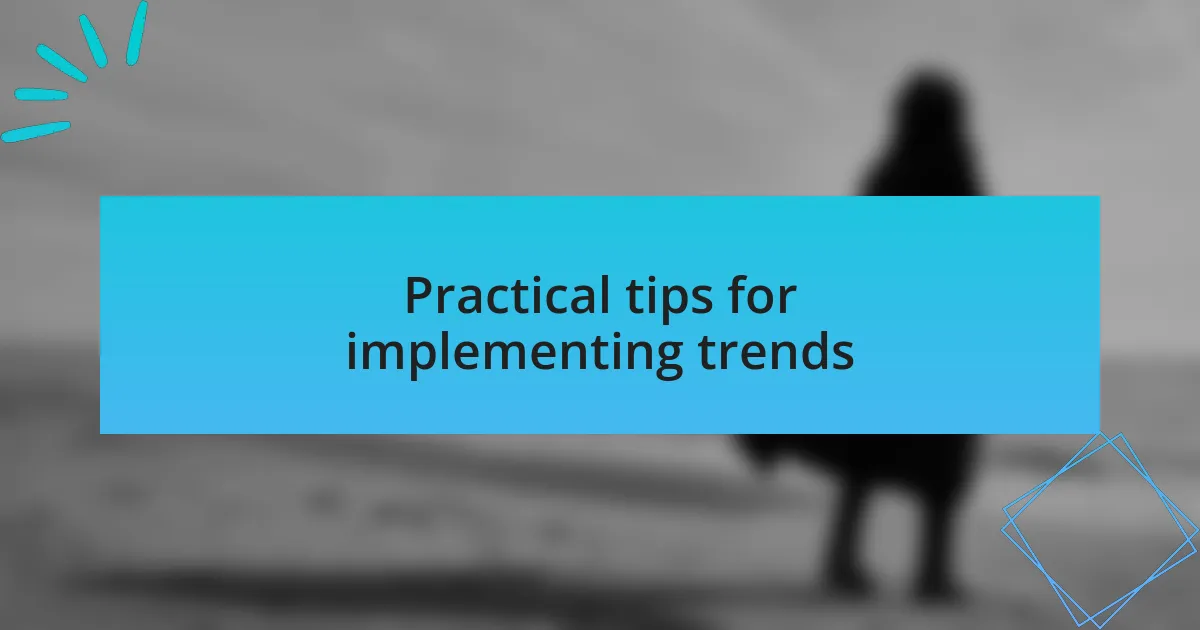
Practical tips for implementing trends
When implementing typography trends, one practical tip is to begin with a clear understanding of your audience. I remember tackling a project for a youth-focused brand; I chose playful, whimsical fonts that resonated with their vibrant spirit. It was incredible to see how the typography choices created an instant connection—almost like speaking their language. Have you ever tried to capture the essence of your audience through font selection?
Experimentation also plays a significant role in finding the right typography. While designing a campaign for a non-profit, I combined bold type with understated serif fonts to create a striking contrast. The end result captivated the viewers and drew them into the cause. Sometimes, blending different styles can breathe fresh life into a design; have you considered mixing fonts to find an unexpected yet harmonious balance?
Lastly, testing your typography choices in different contexts is essential. On a recent app redesign, I tested various type sizes and weights to see how they performed on different devices. The feedback was eye-opening—what looked good on desktop didn’t always translate to mobile. This hands-on approach not only fine-tuned the legibility but also enhanced user engagement. Have you explored how your typography stands up across different platforms?